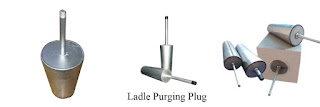The structure and working principle of AOD furnace
In 1991, 75.6% of the world's total stainless steel production was
produced by the AOD method (8 million tons of stainless steel). The
proportion of using AOD refining technology at home and abroad is
increasing.
The type of AOD furnace is similar to that of LD converter. The
supporting trunnion of the furnace body can be tilted at any angle. The
AOD furnace is placed in a rotating support shaft ring connected with
the tilting shaft. The container can rotate forward 180° at a variable
speed and 80° backward.
AOD equipment mainly consists of furnace body, trunnion ring, tilting
mechanism, gas mixing feeding system, temperature measurement and
sampling system. The AOD furnace is lined with refractory materials
such as magnesia and chromium, and the lower part is designed as a cone
with an inclination angle of 20°. The purpose is to make the incoming
gas rise away from the furnace wall to avoid erosion of the upper
furnace wall of the tuyere. There are 2 or more tuyere on the bottom
side of the furnace to prepare for blowing gas into the molten pool.
When steel, the furnace body is tilted forward, the tuyere is exposed on
the liquid surface of the ladle, and the tuyere is buried in the deep
part of the molten pool during normal blowing.
The amount of refined gas is gradually reduced with the decarburization
process during operation, and is only 0.5 when it reaches the low-carbon
range. At the end of decarburization, ferrosilicon alloy, etc. are
added for argon stirring to recover chromium in the slag, desulfurize
if necessary, and adjust the composition and temperature of molten
steel before tapping. During decompression and inert gas stirring
treatment, the gas content in steel is lower than that in electric arc
steelmaking. The shape of the AOD furnace body determines that the
amount of gas blown in per ton of molten steel per unit time is large,
so the decarburization rate is high and the processing time is short.
This is one of the characteristics of the AOD method, and the equipment
cost is low.
The basic principle of the AOD method is similar to that of decarburization under vacuum. The latter uses vacuum to reduce the carbon monoxide partial pressure of the decarburized product, while the AOD method uses gas dilution to reduce the carbon monoxide partial pressure without the need for expensive vacuum equipment facility. When smelting stainless steel, for crude molten steel containing both carbon and chromium, oxygen must be blown into the molten steel to oxidize the carbon in it without producing too much chromium. Then, the molten steel is mixed with a side blowing oxygen lance. Dilute carbon dioxide with argon to reduce the partial pressure of argon and oxygen, so as to achieve the purpose of decarburization and chromium preservation. Due to the blowing of high-pressure argon-oxygen mixed gas, the chance of contact between molten steel and bubbles and slag increases, which is convenient for rapid decarburization. , It is also conducive to rapid desulfurization, degassing and non-metallic inclusions, which is the holding point of the AOD furnace refining process.
Wanhao is a manufacturer who is specialized in designing various kinds of furnace and making refractory products for electric furnace, ladle, tundish, blast furnace, AOD furnace, IF furnace, etc.
Article Source:Introduction and selection of burner bricks
More Refractory Products:https://www.wanhaorefractory.com/en/product.html
Website:https://www.wanhaorefractory.com/


评论
发表评论